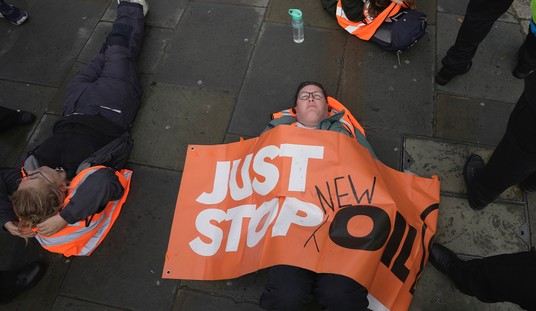This is good news, although how good remains a matter of debate.
The mystery at the heart of the epidemic is how many people have had coronavirus while experiencing few or no symptoms. The University of Oxford’s model speculates that as many as half of all Brits might have it, which would be wonderful news. It would mean that virtually everyone who gets it shrugs it off with little difficulty; the people crowding hospitals are extreme outliers, prone to severe symptoms for reasons that aren’t clear. It would also mean that we’re much closer to herd immunity, in which 50-75 percent of the population has recovered from an infection, than we realize. There won’t be 12-18 months of “waves” of the disease. There’ll be one epidemic curve and we’re in the middle of it right now.
To know if Oxford is right or wrong, we need blood from a random sample of the population to see how many people have COVID-19 antibodies, the smoking gun that proves someone has had the virus and recovered from it. A study like that was done recently in the German town of Gangelt, in Heinsberg. Result: 15 percent, which is three to five times higher than experts’ best guesses of what percentage of the U.S. is infected.
Data from coronavirus deaths in Gangelt suggests an infection mortality rate of 0.37 percent, significantly below the 0.9 percent which Imperial College has estimated, or the 0.66 percent found in a revised study last week.
The 15 percent figure from Gangelt is interesting because it matches two previous studies. Firstly, there was the accidental experiment of the cruise ship the Diamond Princess, which inadvertently became a floating laboratory when a passenger showing symptoms of COVID-19 boarded on January 20 and remained in the ship, spreading the virus, for five days. The ship was eventually quarantined on February 3 and all its 3,711 passengers tested for the virus. It turned out the 634 of them — 17 percent — had been infected, many of them without symptoms. The mortality rate on the vessel was 1.2 percent — although, inevitably being a cruise ship, it was a relatively elderly cohort.
We gained another insight into SARS-CoV-2 from a Chinese study into 391 cases of COVID-19 in the southern Chinese city of Shenzhen. In this case, scientists tested everyone who shared a household with people who were found to be suffering from the disease. It turned out 15 percent of this group had gone on to be infected with SARS-CoV-2 themselves. Again, many showed no symptoms.
Fifteen percent was also what Spain’s infection rate was estimated to be per a model (not a serological study) published late last month. The good news from Gangelt, obviously, is the possibility that COVID-19’s fatality rate is much lower than everyone thinks due to the iceberg of asymptomatic cases lurking beneath the surface of the data, largely undetectable. But is Gangelt an outlier or representative of Germany as a whole? The wrinkle is that the virus arrived there early, in February, via a carnival attended by thousands. It had a lot of time and opportunity to circulate locally. That being so, some scientists think 15 percent transmission isn’t cause for optimism under the circumstances:
“To me it looks like we don’t yet have a large fraction of the population exposed,” says Nicholas Christakis, a doctor and social science researcher at Yale University. “They had carnivals and festivals, but only 14% are positive. That means there is a lot more to go even in a hard-hit part of Germany.”…
Early results from hospitals are already circulating among some experts, says Christakis, who thinks these data will get us “closer to the truth” about how far the infection has spread in US cities. “If you see 5% positive in your health-care workers, that means infection rates probably aren’t higher than that in your city,” he says.
If New York City had “only” 15 percent infected, would that be good or bad news at this point? It would mean 1.2 million people were immune, for a true fatality rate of around 0.5 percent — but it would also mean 7.4 million were still vulnerable even after a nightmarish month, with herd immunity still a long way away. Also, bear in mind that the model that estimated 15 percent infection in Spain had much lower estimates for most other European countries:

What’s more, there’s reason to believe that coronavirus deaths are being undercounted — possibly by a lot — which means the true fatality rate would be higher than we expect. Here’s Lyman Stone’s visualization of deaths in New York State over time:
Okay. We have new data.
Deaths in New York rose by a LOT more than expected in Week 13. pic.twitter.com/RVZrru9A0n
— Lyman Expand the House Stone, AKA 石來民 (@lymanstoneky) April 10, 2020
The many multicolored lines bunched around the 3,000 line show deaths from all causes week to week in New York during previous years. The solid red line shows deaths from all causes week to week this year. The solid black line shows confirmed COVID-19 deaths week to week this year. Notice the massive spike in the red line in weeks 11-12, when official coronavirus deaths were just beginning to appear. That’s a LOT of unexplained “excess” deaths. And given how sharply the black line has risen this past week, the spike in the next red line should be truly massive. Stone’s guess is sensible: “Hospitals may not be overwhelmed simply because many people are dying alone in their homes [from coronavirus] without any medical care at all.” We already have plenty of anecdotal evidence of that, in fact. This is much worse than the flu, even if the death rate from the disease ends up being lower than thought.
Here’s another visualization showing how freakish the spike is:
Brutal visualization of all-cause mortality in NYC over the past 20 years https://t.co/3ATmBOX2RC pic.twitter.com/rFC6ozwrGD
— Joe Pickrell (@joe_pickrell) April 10, 2020
Even so, it’s possible that the Oxford model is right and what we’re seeing right now with the death spike in New York is a tiny fraction of a much bigger infected population that’s recovering from the disease with few symptoms. Some point to the fact that there was an increase in “non-flu flu-like illness” last month even before COVID-19 was supposed to have been spreading widely as evidence that many more were being infected than doctors realized:
The widespread flu-like-illness in March throughout the US, without ability to test for #COVID19, might actually be good news, indicative of a lower fatality rate https://t.co/CIFKbimxVB @TheEconomist https://t.co/T2BnUsVUtY by @inschool4life @Alex_Washburne pic.twitter.com/KO8IvFOLUs
— Eric Topol (@EricTopol) April 8, 2020
Others point to the fact that California has had a minor outbreak despite its massive size and wonder: Could the state have encountered the virus sooner than known, with many millions developing immunity before COVID-19 made an impact nationally?
The trend has been particularly surprising, experts say, given the state has a large number of people in poverty and homelessness, and saw a substantial amount of travel to and from China last year.
One theory centers around the idea of herd immunity – the concept that a large percentage of a population has already contracted and become immune to an infection, slowing the rate at which it spreads to others.
Stanford researchers are looking into the possibility that coronavirus first hit California undetected last year, much earlier than anyone realized, and was only seen at that time as a particularly nasty and early flu season.
The problem with that theory, though, is that California hasn’t experienced any freakish death spikes like New York has. New York is slowly en route to herd immunity right now and there’s an immense amount of suffering involved. To believe that California has already arrived there, you need to explain why their path didn’t require anything like the same amount of suffering.








Join the conversation as a VIP Member